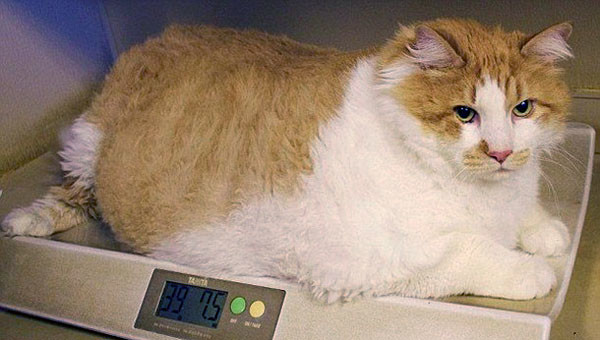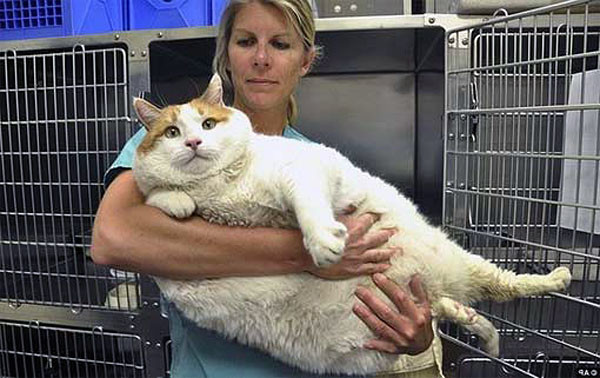 Фото:Press Service ArchivesThe problem of excess weight is one of the most common problems of the 21st century for humans, as well as for cats and dogs. The only difference is that humans can control their weight themselves and, if necessary, begin to take measures, while pets are completely dependent on their owners and suffer in silence. Yes, they do suffer, since an increase in body weight by 15-20% can already lead to health problems. Over the past decades, scientific advances have turned the usual ideas about adipose tissue as thermal insulation, an energy depot, and structural support for some organs upside down. Scientists have proven that adipose tissue is metabolically active and is the largest endocrine organ with unlimited growth potential. Understanding that adipose tissue is not inert has contributed to the establishment of a complex relationship with some diseases in humans, such as heart disease, diabetes, and chronic osteoarthritis. Unfortunately, the forecasts for the future are grim. By 2015, 65% of Europe's population will be overweight. What awaits our pets? Already now, according to scientists, in the USA and other developed countries the number of dogs and cats that are overweight has reached epidemic proportions. In the USA, more than 35% of adult cats suffer from , and 45% of animals over the age of 10–11 years.
Фото:Press Service ArchivesThe problem of excess weight is one of the most common problems of the 21st century for humans, as well as for cats and dogs. The only difference is that humans can control their weight themselves and, if necessary, begin to take measures, while pets are completely dependent on their owners and suffer in silence. Yes, they do suffer, since an increase in body weight by 15-20% can already lead to health problems. Over the past decades, scientific advances have turned the usual ideas about adipose tissue as thermal insulation, an energy depot, and structural support for some organs upside down. Scientists have proven that adipose tissue is metabolically active and is the largest endocrine organ with unlimited growth potential. Understanding that adipose tissue is not inert has contributed to the establishment of a complex relationship with some diseases in humans, such as heart disease, diabetes, and chronic osteoarthritis. Unfortunately, the forecasts for the future are grim. By 2015, 65% of Europe's population will be overweight. What awaits our pets? Already now, according to scientists, in the USA and other developed countries the number of dogs and cats that are overweight has reached epidemic proportions. In the USA, more than 35% of adult cats suffer from , and 45% of animals over the age of 10–11 years. A photo: Archives of press services In this regard, it is necessary to categorically review their attitude to the well-being of their pet, determine its degree and, if it turns out that it is above the norm, take measures. What is the risk factor for development? Heredity. Cats of mixed breeds, as well as tailless cats are more prone to obesity. Sex / sterility. Cats are more prone to, and castration increases the risk of health problems by 25% .3. Age. The risk of obesity increases with age. Activity. Decreased activity increases the risk of gaining weight. Food and feeding. Easily assimilated food with high caloric content, free-feeding, non-compliance with feeding norms, excessive number of delicacies. Cats are associated with type 2 diabetes mellitus, neoplasms, dental diseases, skin diseases, lower urinary tract diseases. In addition, obesity exacerbates the existing diseases of the musculoskeletal system, respiratory and heart failure, worsens wound healing and complicates the course of pregnancy. Overweight reduces the life of the animal on average by 2 years. Preventing or correcting obesity can delay or prevent the development of many diseases associated with being overweight, and prolong the life of your pet. The simplest solution to this problem is to resort to feeds that will help successfully cope with obesity.
A photo: Archives of press services In this regard, it is necessary to categorically review their attitude to the well-being of their pet, determine its degree and, if it turns out that it is above the norm, take measures. What is the risk factor for development? Heredity. Cats of mixed breeds, as well as tailless cats are more prone to obesity. Sex / sterility. Cats are more prone to, and castration increases the risk of health problems by 25% .3. Age. The risk of obesity increases with age. Activity. Decreased activity increases the risk of gaining weight. Food and feeding. Easily assimilated food with high caloric content, free-feeding, non-compliance with feeding norms, excessive number of delicacies. Cats are associated with type 2 diabetes mellitus, neoplasms, dental diseases, skin diseases, lower urinary tract diseases. In addition, obesity exacerbates the existing diseases of the musculoskeletal system, respiratory and heart failure, worsens wound healing and complicates the course of pregnancy. Overweight reduces the life of the animal on average by 2 years. Preventing or correcting obesity can delay or prevent the development of many diseases associated with being overweight, and prolong the life of your pet. The simplest solution to this problem is to resort to feeds that will help successfully cope with obesity.

Making Money with Desserts: Success Stories
Evgeniya Polischuk (Fedutinova) instagram:@evgeniyafedutinovavk.com/janeshomebaking– It all started with baking for family and friends. Gradually, I started posting photos of my baked goods on Instagram – and orders started coming in. I made my first custom-made cake on October 13, 2014, and a little earlier I started making macaroons and cupcakes. You could say that the business “found me”, I am very […]

Soups are cold recipes with photos
Cold cucumber soup with yogurt and lemonsorbet from the chef of the restaurant La Taverna Alexander Zhurkin Photo: Getty Images Ingredients: Plain yoghurt – 125 g Cucumber – 150 g Lemon/lime sorbet – 50 g Cocktail shrimp – 24 g Fresh ginger juice – 1 g Lime juice – 5 g Fresh orange juice – 5 g Parsley – 1 g Pink pepper – 1 g Watercress – […]

barbeque kebab
Pork tenderloin in glaze Photo:Dmitry Bayrak/dbstudioPreparation time: 20 minutes + marinating time.Calories: 454 kcal per serving.For 4 servings: 4 pork tenderloins (approximately 300 g each), 1 onion, 2 cloves of garlic, 1 tsp. lemon zest, 1 tsp. lemon juice, a pinch of ground cumin, coriander and turmeric, 1 tbsp. vegetable […]

Pierre Duacan: dietary recipes: Ducane diet
Beetroot soup Photo:Season’S, Luxury Hotels RepresentationYou will need:· Boiled beetroot – 60 g· Fresh cucumbers – 20 g· Red radish – 20 g· Green onions – 10 g· Egg – 1 pc.· Drinking mineral water – 200 g· Salt – 1 gPreparation:· Boil the egg and beetroot.· Grate the cucumbers, radish and part of the beetroot. Put everything […]





